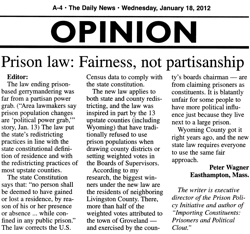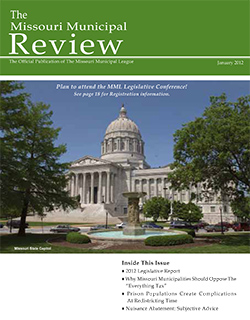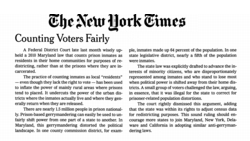The Daily News recently published a letter to the editor by Peter Wagner explaining that the law ending prison-based gerrymandering in New York is about democratic fairness rather than petty partisanship.
by Leah Sakala,
January 27, 2012
 In reviewing recent coverage of New York’s implementation of the 2010 law that ended prison-based gerrymandering, I was struck by how often partisan interests misrepresent a law that protects the fundamental Constitutional mandate of “one person, one vote.”
In reviewing recent coverage of New York’s implementation of the 2010 law that ended prison-based gerrymandering, I was struck by how often partisan interests misrepresent a law that protects the fundamental Constitutional mandate of “one person, one vote.”
The Daily News recently published a letter to the editor by PPI’s Executive Director Peter Wagner that clarifies that the New York law is about fundamental democratic fairness, not petty partisanship. Upstate counties, it turns out, took the lead in rejecting prison-based gerrymandering because of the way it was distorting their districts.
As Peter explains:
Prison law about fairness, not partisanship
The law ending prison-based gerrymandering was far from a partisan power grab. (“Area lawmakers say prison population changes are ‘political power grab,’” story, Jan. 13) The law put the state’s redistricting practices in line with the state constitutional definition of residence and with the redistricting practices of most upstate counties.
The state Constitution says that: “no person shall be deemed to have gained or lost a residence, by reason of his or her presence or absence … while confined in any public prison.” The law corrects the U.S. Census data to comply with the state constitution.
The new law applies to both state and county redistricting, and the law was inspired in part by the 13 upstate counties (including Wyoming) that have traditionally refused to use prison populations when drawing county districts or setting weighted votes in the Boards of Supervisors.
According to my research, the biggest winners under the new law are the residents of neighboring Livingston County. There, more than half of the weighted votes attributed to the town of Groveland — and exercised by the county’s boards chairman — are from claiming prisoners as constituents. It is blatantly unfair for some people to have more political influence just because they live next to a large prison.
Wyoming County got it right years ago, and the new state law requires everyone to use the same fair approach.
Peter Wagner
Easthampton, Mass.
The writer is executive director of the Prison Policy Initiative and author of “Importing Constituents: Prisoners and Political Clout.”
The January, 2012 issue of the Missouri Municipal Review includes my article on how prisons create problems for Missouri cities at redistricting time.
by Peter Wagner,
January 27, 2012

The January, 2012 issue of the Missouri Municipal Review includes my new article on how the Census Bureau’s prison miscount creates problems for Missouri cities at redistricting time. Since the Census Bureau counts incarcerated people as they they were residents of the cities in which they are confined, city officials who are redrawing city council lines must decide whether the people who live next to the prison should be given more influence over city affairs than other residents.
The article grew out of our work in the City of Pacific, where the city proposed drawing a city council district where almost half of the population was incarcerated, thereby diluting the votes of residents in all other districts.
The article explains that both federal law and Missouri state law permit municipalities to adjust their redistricting data to avoid prison-based gerrymandering, and at least two Missouri cities have successfully done so this redistricting season.
The article includes a section on Missouri state law, but it also includes a good national introduction to the topic, with sections on federal law and a detailed discussion of the factual and legal precedent for avoiding prison-based gerrymandering across the country. In the article, I explain that removing prison populations from redistricting data is a common (and common sense) approach used by more than 100 local governments across the country. The article ends with a discussion of best practices for avoiding prison-based gerrymandering.
The article came out too late for some cities that have completed their redistricting — Fulton has a district that is 47% incarcerated, Chillicothe has a district that is 39% incarcerated, and St. Joseph has a district that is 13% incarcerated — but the article will hopefully help other cities as they update their districts.
New video (using an example district that was drawn in New York after the 2000 Census) explains how prison-based gerrymandering can alter district lines.
by Leah Sakala,
January 27, 2012
Curious about why prison-based gerrymandering is a big deal when it’s time to draw districts?
We have a new video that explains how prison-based gerrymandering can alter district lines. The video uses as its example a district that was drawn in New York after the 2000 Census.
For more videos about prison-based gerrymandering and redistricting, check out our video page.
Today the New York Times printed an editorial praising a Federal District Court’s decision to uphold the 2010 law that ended prison-based gerrymandering in Maryland.
by Leah Sakala,
January 17, 2012

Today the New York Times editorial board praised a Federal District Court’s decision to uphold the 2010 law that ended prison-based gerrymandering in Maryland. The law had been challenged by plaintiffs in Fletcher v. Lamone.
The editorial states:
Counting Voters Fairly
A Federal District Court late last month wisely upheld a 2010 Maryland law that counts prison inmates as residents in their home communities for purposes of redistricting, rather than at the prisons where they are incarcerated.
The practice of counting inmates as local “residents” — even though they lack the right to vote — has been used to inflate the power of mainly rural areas where prisons tend to placed. It undercuts the power of the urban districts where the inmates actually live and where they generally return when they are released.
There are about 1.5 million people in prison nationally. Prison-based gerrymandering can easily be used to unfairly shift power from one part of a state to another. In Maryland, this gerrymandering distorted the political landscape. In one county commission district, for example, inmates made up 64 percent of the population. In one state legislative district, nearly a fifth of the population were inmates.
The state law was explicitly drafted to advance the interests of minority citizens, who are disproportionately represented among inmates and who stand to lose most when political power is shifted away from their home districts. A small group of voters challenged the law, arguing, in essence, that it was illegal for the state to correct for prisoner-related population distortions.
The court rightly dismissed this argument, adding that the state was within its rights to adjust census data for redistricting purposes. This sound ruling should encourage more states to join Maryland, New York, Delaware and California in adopting similar anti-gerrymandering laws.
Case documents, related materials, and selected news coverage are available on our Fletcher v. Lamone page.
New York's partisan vortex makes an agreement to follow the law ending prison-based gerrymandering appear to be a change in the text of the law. It's not.
by Peter Wagner,
January 13, 2012
Numerous press reports in the last few days have described the implementation of New York’s law ending prison-based gerrymandering as a “deal”, with language like this one:
“Under the deal, prisoners won’t be counted if records can’t identify the specific election district they lived in last.”
That’s factually incorrect. The “deal” was that the Assembly and the Senate agreed to follow the law which requires that the ‘populations’ of prisons not be used as the basis for drawing districts, and that prisoners be counted instead at their prior home addresses. The law further requires that those whose homes are out-of-state, or for whom address information is lacking, not be included in the redistricting database.
While the Senate Majority made it clear they did not like the law, they never contested this reading of the law. During the most recent round of stalling over implementation of the law, the dispute within the Legislature’s Redistricting Task Force appears to have been over the adequacy of some of the available address information and over which software package was most appropriate for locating the home addresses.
Given the partisan vortex in New York, it’s easy to see how reporters coming late to the issue, and interviewing back-bench politicians, could write stories that conflate pre-existing details of the law with a groundbreaking “deal”. But what the Senate and Assembly finally agreed to do on January 10 was to stop arguing over microscopic details and to release one adjusted dataset that can be used for state and local redistricting. In other states, that wouldn’t even be “news”, let alone a “deal”.
New issue of Urban Habitat's journal includes an article about how Census Bureau’s miscount of incarcerated people distorts our democracy and impedes racial justice.
by Leah Sakala,
January 13, 2012
The newest issue of Race, Poverty & the Environment includes a “Geography of Race” section with an article I wrote on how the Census Bureau’s miscount of incarcerated people distorts our democracy and impedes racial justice. The Race, Poverty & the Environment journal is a project of Urban Habitat.
New York task force has released population data to be used for state and local redistricting, which counts incarcerated people at their home addresses.
by Peter Wagner,
January 6, 2012
After months of public concern that the New York Senate did not intend to implement the law ending prison-based gerrymandering, last night the redistricting taskforce, LATFOR, released the population data to be used for state and local redistricting, which counts incarcerated people at their home addresses. You can download the data and the accompanying documentation on the LATFOR website.
New Roanoke Times (VA) editorial calls on the Virginia legislature to take a stand against prison-based gerrymandering by passing H.B. 13
by Leah Sakala,
January 6, 2012
This week, the Roanoke Times (Virginia) published a strong editorial calling on the Virginia legislature to take a stand for equal representation by passing H.B. 13. This legislation, sponsored by Delegate Riley Ingram, would more than double the number of counties eligible to reject prison-based gerrymandering by not artificially padding their districts with incarcerated populations.
Here’s the editorial:
Prisoners shouldn’t pad electoral districts
Let small localities with comparatively big prisons skip the prisoners when redistricting.
Prisoners skew the electoral map in some Virginia communities because they count as residents where they are incarcerated. They may not vote, though, so the rest of the people in a district with a prison receive greater political power than their neighbors.
Del. Riley Ingram, R-Hopewell, has introduced a bill to allow a few more localities to end such local prison-based gerrymandering. If H.B. 13 becomes law, localities would not have to count prisoners when they draw their legislative maps if the prisoners would constitute at least 12 percent of the ideal population of a district.
That would not affect redistricting for state or federal offices, only local offices.
The 12 percent threshold is a vestigial organ from existing law. In 2001, lawmakers gave localities the option to ignore prisoners in redistricting if 12 percent of all residents were prisoners. Ingram’s bill simply shifts the same percentage to a single district.
The nonpartisan Prison Policy Initiative identifies more than a dozen Virginia localities that could stop padding districts with prisoners. None is around these parts, but Pulaski and Pittsylvania counties both have incarceration facilities that could be eligible in 2021, when the next redistricting takes place.
Ingram sponsored a similar bill last year. It passed the House of Delegates on a 99-0 vote, but it died in the Senate Privileges and Elections Committee. Local senators split on the committee vote. Sen. John Edwards, D-Roanoke, supported the bill. Sen. Ralph Smith, R-Roanoke County, opposed it.
It faces better prospects this year. The evenly divided Senate is now under Republican control with the tie-breaking vote of Lt. Gov. Bill Bolling. Moreover, the NAACP has come out in favor of the change, contradicting concerns raised last year that blacks would oppose the measure.
Ideally, the General Assembly would simply allow all localities not to count prisoners in their local districts. After all, whether they are 5 percent or 15 percent of the population in a district, they artificially boost the population count and the political clout of some voters.
Ingram’s bill does not go that far, but it would move the commonwealth in the right direction.
For more information about the bill, check out our recent blog posts Virginia bill would help counties avoid prison-based gerrymandering, and Virginia counties may be given more choices in avoiding prison-based gerrymandering.
Interactive redistricting tools use our analysis of Census data to adjust redistricting population in New York.
by Aleks Kajstura,
January 4, 2012
New York residents, so far facing a shortage of accurate redistricting data, are provided a partial solution by two new district mapping tools available online.
New York law requires that redistricting population data count incarcerated people at their home addresses. And although New York’s Legislative Task Force on Redistricting (LATFOR) is required to release the adjusted redistricting data, it has yet to do so. This poses a problem for the state’s residents and organizations that want to propose their own redistricting plans for consideration by the LATFOR.
Two online interactive redistricting tools make some of the required data available: The Public Mapping Project‘s District Builder and Common Cause/Newsday collaboration, UMapNY.
District Builder and UMapNY both use population data that account for half of the prison-based gerrymandering problem: while these tools could not count incarcerated people at their home addresses, the prison populations were removed form the population totals of the locations with the prisons to give a more accurate reflection of the state’s population distribution. Both tools use our analysis of the Census Bureau’s Group Quarters data to adjust the population of the 79 Census blocks that contain correctional facilities affected by the law.
These tools allow the residents of NY State to create draft maps with the most accurate redistricting data available so far.






